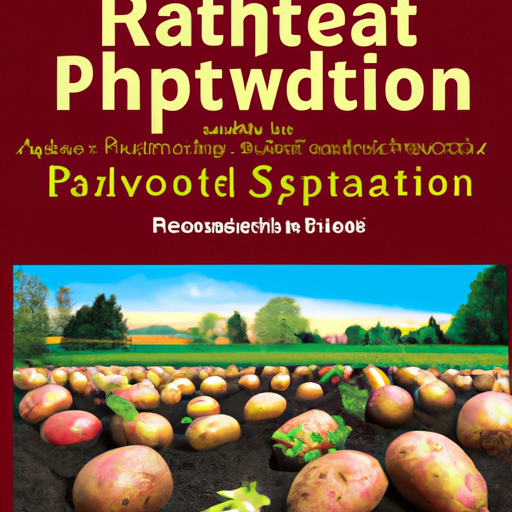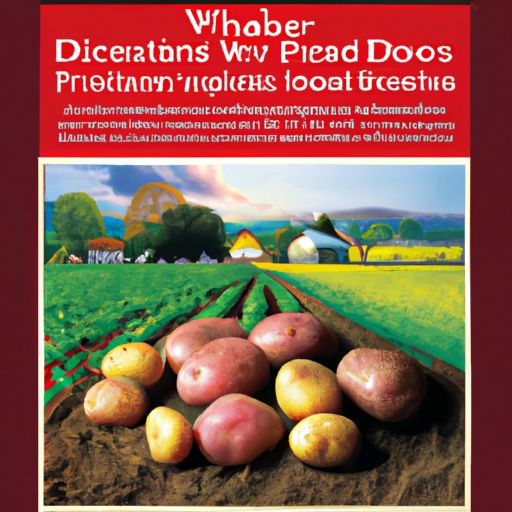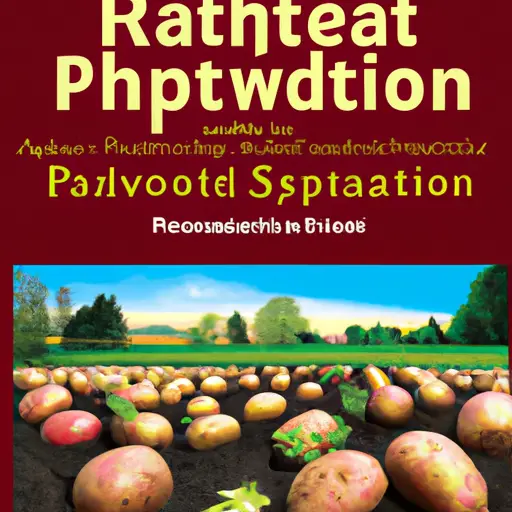So, have you ever wondered how long it takes for potatoes to grow? I mean, they’re such a staple food in so many cuisines, but most of us don’t really know how they go from being just a tiny seed to those delicious spuds we love to eat. Well, let me fill you in on the growing process of potatoes, and trust me, it’s pretty fascinating.
First things first, potatoes are usually grown from seed potatoes, which are basically small potatoes that are ready to sprout and produce new plants. These seed potatoes are planted in well-prepared soil, usually in early spring, when the ground is no longer freezing. Once planted, the potatoes need consistent moisture and sunlight to thrive.
Now, when it comes to the actual growing time, it can vary depending on the potato variety and growing conditions. On average, it takes about 70 to 120 days for potatoes to mature and be ready for harvest. Yeah, that’s a bit of a wait, but trust me, it’s worth it. And during this growing period, the potato plants go through a series of stages, starting from sprouting and eventually forming those beautiful tubers we enjoy.
But hey, don’t worry, I’ll dive deeper into each stage and provide even more details in the full article. So, if you’re interested in learning more about the fascinating growing process of potatoes, from planting to harvesting, stick around and I’ll give you all the juicy details. Trust me, you’ll become a potato-growing expert in no time!

The Growing Process of Potatoes
Are you considering growing your own potatoes? It’s a rewarding experience that allows you to enjoy fresh and flavorful potatoes straight from your own garden. But before you start planting, it’s important to understand the process of growing potatoes. From choosing the right variety to harvesting and using them in your favorite recipes, there are several key steps to follow for successful potato cultivation. In this article, we will guide you through the entire growing process of potatoes, providing you with essential tips and techniques to ensure a bountiful harvest.
Choosing the Right Potato Variety
One of the first steps in growing potatoes is selecting the right variety for your specific needs. There are numerous potato varieties available, each with its own unique characteristics. When choosing a variety, it’s important to consider the growing conditions in your area. Some potato varieties thrive in cooler climates, while others are more suited for warmer regions.
Consider the Growing Conditions
Potatoes prefer cool weather and well-drained soil. They thrive in areas with temperatures between 60 to 70 degrees Fahrenheit during the day and 50 to 60 degrees Fahrenheit at night. If you live in an area with hot summers, it’s crucial to choose a variety that can tolerate higher temperatures. Additionally, potatoes require at least six to eight hours of sunlight each day, so be sure to select a location in your garden that receives adequate sunlight.
Research Different Potato Varieties
To find the perfect potato variety for your needs, it’s essential to do some research. Look for varieties that are known for their flavor, texture, and resistance to common diseases. Popular potato varieties include Russet, Yukon Gold, Red Pontiac, and Fingerling. Each variety has its own unique taste and texture, so consider your preferences when making a selection.
Selecting the Best Potato Variety for Your Needs
Once you have considered the growing conditions and researched different potato varieties, it’s time to select the best one for your needs. Consider factors such as yield, cooking qualities, and disease resistance. If you’re new to potato cultivation, it’s a good idea to choose a variety that is known for its adaptability and ease of growing.
Preparing the Soil for Planting
The next step in the growing process of potatoes is preparing the soil. Proper soil preparation is crucial for healthy plant growth and a successful harvest.
Testing the Soil
Before planting, it’s important to test your soil to determine its nutrient content. You can purchase a soil testing kit or send a soil sample to a local agricultural extension office. The results will provide valuable information about the pH level of your soil, as well as any nutrient deficiencies that need to be addressed.
Amending the Soil
Based on the results of your soil test, you may need to amend the soil to create the ideal growing conditions for potatoes. Potatoes require a soil pH between 5.0 and 6.5 for optimal growth. If your soil is too acidic, you can add lime to raise the pH. Conversely, if your soil is too alkaline, you can add sulfur to lower the pH. Additionally, adding organic matter such as compost or well-rotted manure will improve the soil structure and provide essential nutrients for the growing potatoes.
Creating Raised Beds
To further improve soil drainage and prevent waterlogging, consider creating raised beds for planting your potatoes. This will allow excess water to drain away, preventing root rot and other water-related diseases. Raised beds also provide better weed control and make it easier to monitor the growth of your potato plants.
Planting Potatoes
Now that you have prepared the soil, it’s time to plant your potatoes. Proper planting techniques will give your potatoes a strong start and promote healthy growth.
Preparing Seed Potatoes
Potatoes are typically grown from seed potatoes, which are small tubers specifically grown for planting. Before planting, it’s important to prepare your seed potatoes. Start by inspecting them for any signs of disease or rot. Discard any damaged or diseased potatoes. Then, allow the seed potatoes to sit in a cool and dry location for a few weeks. This process, known as curing, allows the skin of the potatoes to toughen, reducing the risk of rotting in the soil.
Cutting Seed Potatoes
If your seed potatoes are large, you may need to cut them into smaller pieces before planting. Each piece should have at least two “eyes,” which are small depressions where the sprouts will emerge. Be sure to use a sharp, clean knife to avoid introducing any pathogens into the potatoes. After cutting, allow the pieces to dry and form a callus before planting.
Planting Potatoes in Trenches or Holes
Potatoes are typically planted in either trenches or holes. Trench planting involves digging a trench that is six to eight inches deep. Place the seed potatoes in the trench, with the eyes facing up, and cover them with soil. Alternatively, you can dig individual holes about six to eight inches deep and place a seed potato in each hole. Plant the potatoes about twelve inches apart to allow for proper growth and development.

Watering and Fertilizing
Proper watering and fertilizing are essential for healthy potato plants and a successful harvest.
Proper Watering Techniques
Potatoes require consistent moisture throughout the growing season. However, it’s important to strike a balance and avoid overwatering, as this can lead to root rot and other diseases. Water your potato plants regularly, aiming for about one inch of water per week. If you’re unsure whether your plants need watering, check the soil moisture levels by inserting your finger into the soil. If it feels dry, it’s time to water.
Applying Fertilizer
Potatoes are heavy feeders and require regular fertilization to ensure optimal growth. Before planting, incorporate a balanced fertilizer into the soil. This will provide the potatoes with essential nutrients needed for healthy development. As the plants grow, you can also side-dress them with additional fertilizer to promote strong foliage and tuber production. Be sure to follow the instructions on the fertilizer packaging for proper application rates.
Monitoring Moisture Levels
In addition to regular watering, it’s important to monitor moisture levels in the soil. Potatoes require consistent moisture, especially during the tuber formation stage. If the soil is too dry, the tubers may not develop properly and may end up deformed or stunted. Regularly check the moisture levels in the soil and adjust your watering schedule accordingly to ensure healthy potato growth.
Managing Weeds and Pests
Weeds and pests can pose a threat to your potato plants and reduce your harvest. Proper weed management and pest control are essential for a successful crop.
Mulching to Suppress Weeds
Mulching is an effective method to suppress weeds and conserve soil moisture. Apply a layer of organic mulch, such as straw or shredded leaves, around your potato plants. The mulch will smother weed growth and help keep the soil temperature consistent. Additionally, the mulch will break down over time, providing additional nutrients to the growing potatoes.
Hand Pulling Weeds
Despite mulching, some weeds may still manage to grow. It’s important to regularly inspect your potato plants and hand-pull any weeds that emerge. Be sure to remove the weeds carefully, ensuring that you do not disturb the potato plants or their delicate root systems.
Using Organic Pest Control Methods
Potatoes can attract various pests, including Colorado potato beetles and aphids. To control pests in an organic and environmentally friendly way, you can introduce beneficial insects such as ladybugs or lacewings that prey on aphids. Additionally, you can use organic sprays or neem oil to deter pests. Regularly inspect your potato plants for signs of pest infestation and take appropriate measures to prevent damage to your crop.
Hilling or Mounding
Hilling or mounding is an important step in the growing process of potatoes. This technique involves piling soil around the base of the potato plants, covering the lower stems and partially burying the foliage.
Understanding the Importance of Hilling
Hilling is essential for promoting tuber growth and preventing the potatoes from turning green. When exposed to sunlight, potatoes produce a toxin called solanine, which can be harmful if consumed in large quantities. Hilling helps to cover the tubers and protect them from exposure to sunlight, ensuring that they remain safe for consumption.
When to Start Hilling
Start hilling your potato plants when the stems reach a height of about six to eight inches. Use a hoe or a shovel to carefully mound the soil around the base of the plants, covering the lower stems. Leave a small amount of foliage above the mound to allow for continued photosynthesis.
Proper Hilling Techniques
When hilling, be careful not to damage the young potato plants. Gently mound the soil around the base of the plants, forming a small hill. As the plants grow, continue to hill them every few weeks until the hills are about a foot high. This will provide ample soil for tuber development and help prevent the potatoes from turning green.
Monitoring and Protecting Potatoes
As your potatoes continue to grow, it’s important to monitor them for signs of disease and protect them from harsh weather conditions.
Inspecting for Signs of Disease
Regularly inspect your potato plants for signs of disease, such as fungal infections or leaf spots. Common potato diseases include late blight, early blight, and scab. If you notice any signs of disease, take immediate action to prevent the spread. Remove infected plants or affected foliage to reduce the risk of further infection.
Identifying Common Potato Pests
In addition to diseases, potatoes can also be affected by various pests. Common potato pests include Colorado potato beetles, wireworms, and nematodes. If you notice any signs of pest damage, such as chewed leaves or wilting plants, take appropriate measures to control the pests and prevent further damage to your crop.
Protecting Potatoes from Harsh Weather
Potatoes are susceptible to damage from harsh weather conditions such as strong winds, heavy rain, and frost. If a storm is approaching, consider covering your potato plants with row covers or blankets to protect them from damage. Additionally, provide support, such as staking or cages, to prevent the plants from bending or breaking under the weight of the foliage and tubers.
Harvesting Potatoes
When your potatoes have reached maturity, it’s time to harvest them. Harvesting techniques and proper storage are crucial for preserving the quality and flavor of your crop.
Knowing When Potatoes are Ready
Potatoes can be harvested at different stages of maturity, depending on your preferences. If you prefer new potatoes, which are smaller and have a tender skin, you can harvest them when the plants are still flowering. For larger potatoes and a higher yield, wait until the plants have died back and the foliage has turned yellow or brown. At this stage, the tubers are fully mature and ready to be harvested.
Harvesting Techniques
To harvest your potatoes, gently loosen the soil around the base of the plants using a garden fork or shovel. Carefully lift the plants, being mindful not to damage the tubers. Shake off any excess soil and place the harvested potatoes in a basket or container. Avoid exposing the potatoes to direct sunlight, as this can cause them to turn green.
Curing and Storing Potatoes
After harvesting, it’s important to cure and store your potatoes properly. Curing allows the skins to toughen and any minor injuries to heal, resulting in potatoes that will last longer in storage. To cure your potatoes, place them in a cool and dark location with high humidity for about two weeks. After curing, store the potatoes in a cool and dry place, such as a cellar or a basement, away from direct sunlight. Properly stored potatoes can last for several months, providing you with a supply of fresh potatoes throughout the year.
Enjoying and Using Potatoes
Now that you have successfully grown and harvested your potatoes, it’s time to enjoy them in various culinary creations.
Different Culinary Uses of Potatoes
Potatoes are incredibly versatile and can be used in a wide range of culinary dishes. From mashed potatoes and French fries to potato soups and casseroles, the possibilities are endless. Experiment with different cooking methods and recipes to discover your favorite ways to enjoy your homegrown potatoes.
Popular Potato Recipes
If you’re looking for inspiration, here are a few popular potato recipes to try:
- Roasted Garlic Mashed Potatoes: Creamy and flavorful, these mashed potatoes are perfect for holiday dinners or any special occasion.
- Baked Potato Skins: Crispy and delicious, potato skins make a great appetizer or snack.
- Potato Leek Soup: Warm and comforting, this soup is a hearty choice for chilly days.
- Hasselback Potatoes: These thinly sliced potatoes are crispy on the outside and tender on the inside. They make a beautiful side dish for any meal.
Preserving Potatoes for Long-Term Storage
If you have a surplus of potatoes, you can preserve them for long-term storage. One popular method is to can or jar potatoes. This involves peeling and cooking the potatoes, then placing them in sterilized jars with a little water or broth. The jars are then processed in a pressure canner for the recommended amount of time. Canned potatoes can be stored in a cool, dark place and used in various dishes throughout the year.
Conclusion
The growing process of potatoes is a rewarding journey that allows you to enjoy the fruits of your labor and indulge in delicious, homegrown potatoes. By selecting the right variety, preparing the soil, and following proper planting and care techniques, you can ensure a successful potato cultivation experience. Remember to monitor your plants for signs of disease and pests, and protect them from harsh weather conditions. Follow proper harvesting and storage techniques to maximize the shelf life of your potatoes. Whether you enjoy them mashed, roasted, or in your favorite potato recipe, homegrown potatoes are a true delight. So roll up your sleeves and get ready to dig in to the wonderful world of potato cultivation.
Happy growing!




